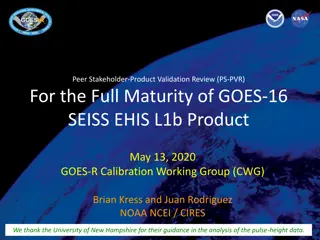Overview of MAAD MAC Address Designation Scheme for IEEE 802.11-22/1650r4
This document discusses the MAAD (MAC Address Designation) scheme proposed for IEEE 802.11-22/1650r4, focusing on its basics, co-existence with Device ID, probe usage, privacy aspects, spoof AP mitigation, and more. The objective is to clarify the simplicity, security, and applicability of MAAD as a solution for TGbh, supporting privacy and pre-association use cases effectively.
Download Presentation

Please find below an Image/Link to download the presentation.
The content on the website is provided AS IS for your information and personal use only. It may not be sold, licensed, or shared on other websites without obtaining consent from the author.If you encounter any issues during the download, it is possible that the publisher has removed the file from their server.
You are allowed to download the files provided on this website for personal or commercial use, subject to the condition that they are used lawfully. All files are the property of their respective owners.
The content on the website is provided AS IS for your information and personal use only. It may not be sold, licensed, or shared on other websites without obtaining consent from the author.
E N D
Presentation Transcript
Oct 2022 doc.: IEEE 802.11-22/1650r4 TG bh Discussion Contribution on MAAD and all that goes with it Date: 2022-09 Authors: Name Company Address Phone email Graham Smith SRT Group Sunrise , FL gsmith@srtrl.com Submission Slide 1 Graham Smith, SR Technologies
Oct 2022 doc.: IEEE 802.11-22/1650r4 Statement Why do I feel that I need to go through all this again? Nothing in this presentation is new, it has all been presented before. BUT Presenting in Telecons has proved to be ineffective and frustrating as when making a presentation at Interim or Plenary, back come the original negative comments that have been covered in detail in presentations made in the Telecons, which maybe the objector has not seen or understood. I realize that this has become controversial subject, but I feel that if the pre-schemes are understood and looked at fully, there is no reasonable reason not to allow at least one of them to be included. I have covered every reasonable objection and comment made against using a pre-scheme. This presentation is meant to be presented at face-to-face, acting as a tutorial, and if presented in telecon, I reserve right to present again in Plenary/Interim before going to the Motions as proposed in 22/1584. Submission Slide 2 Graham Smith, SR Technologies
Oct 2022 doc.: IEEE 802.11-22/1650r4 Outline of this presentation 1. Describe MAAD (one of the pre-schemes ) Still not sure that it is understood by all. 2. Co-existence with Device ID 3. How pre-schemes use Probes 4. Privacy 5. Spoof AP mitigation 6. Clone address 7. Pre-association Use Cases 8. IRMA 9. Conclusions Understand all above so as to be able to return to 22/1584 Submission Slide 3 Graham Smith, SR Technologies
Oct 2022 doc.: IEEE 802.11-22/1650r4 Introduction This MAAD outline s objective is to try to make it clear that MAAD MAC scheme is simple, secure, and an apt solution for TGbh. It supports privacy equal to RCM but adds support for pre-association use cases MAAD also supports a scheme to overcome spoof AP MAAD Text (for D0.2) is in 22/0427r7 Submission Slide 4 Graham Smith, SR Technologies
Oct 2022 doc.: IEEE 802.11-22/1650r4 MAAD (MAC Address Designation)) BASICS: Both STA and AP advertise support AP assigns new MAAD MAC addresses at every RSN association #1 is for association only, #2 is for any probes (when STA wants to be identified) STA uses that NEW allocated address #1 the NEXT time it associates Use address #2 for steering, directed, broadcast probes, if it wants to be identified AP recognizes STA pre-association AP knows the MAC Addresses Reassociation uses MAC address #1 used for the association Must, that s the rule STA can use ANQP and pre-association as usual the MAC address is known/recognized by the AP. Submission Slide 5 Graham Smith, SR Technologies
Oct 2022 doc.: IEEE 802.11-22/1650r4 MAAD Details Outline 1. 2. 3. AP and STA show support for MAAD in Extended Capabilities STA associates first time using 4 W HS MAAD MAC Addresses sent by AP in EAPOL-Key msg 3/4 AP and STA store the allocated MAAD MAC for that STA/AP When STA comes back it uses last allocated MAAD MAC Address as TA AP instantly recognizes the STA from TA (Address #1) in Association Request etc. AP can identify the STA pre-association ANQP and directed probes STA Associates using an allocated MAAD MAC #1 as TA At association, AP provides new MAAD MAC addresses in EAPOL-Key msg 3/4 New MAC Address used for the NEXT association. 4. 5. 6. 7. NOTES For FILS new MAAD MAC addresses received in Association Response frame New Addresses constantly allocated. Submission Slide 6 Graham Smith, SR Technologies
Oct 2022 doc.: IEEE 802.11-22/1650r4 Co-existence with Device ID (see 22/0908r1) AP and STA advertise support for Device ID and MAAD A. AP decides to use Device ID only STA associates AP sends NGID KDE in msg 3 STA logs the ID and sends it in msg 4 on subsequent associations B. AP decides to use MAAD only STA associates AP sends MAAD KDE in msg 3 STA logs the MAAD MAC and uses it on subsequent associations C. AP decides to use both, NGID AND MAAD STA associates AP sends NGID KDE and MAAD KDE in msg 3 STA next associates using the MAAD MAC and sends ID in msg 2 or 4 and AP sends new MAAD MAC in msg 3. Completely compatible no selection mechanism required Submission Slide 7 Graham Smith, SR Technologies
Oct 2022 doc.: IEEE 802.11-22/1650r4 Probes - Active Broadcast (see 22/0955r0) Active Broadcast Probes Looking for networks in range. In general STA should use an RMA (random MAC address) STA may use broadcast probes to find a network May use address #2 if it wants to be identified i.e., knows it is in vicinity of the wanted SSID (discussed later) Submission Slide 8 Graham Smith, SR Technologies
Oct 2022 doc.: IEEE 802.11-22/1650r4 Active Directed Probes Directed probes are discouraged Indicates interest in that AP irrespective of the MAC Address used Even if using RCM , Device ID, MAAD etc. Looking for a specific AP/network? Use broadcast probe (see previous slide) Use Address #2 Is there ever any reason to use an identifiable TA in a broadcast Probe? Yes, if STA knows it is in vicinity of the network, then probing with identifiable TA is OK, e.g., Probes used for steering (next slide) Use address #2 to avoid detection. See later Spoof AP Submission Slide 9 Graham Smith, SR Technologies
Oct 2022 doc.: IEEE 802.11-22/1650r4 Probing in vicinity of Network If in the vicinity of the network, then no problem? Determined by Passive or active (with RMA) scanning, or directed by network for steering purposes Use Address #2 for probes, Address #1 for association If STA probes with different address as it Associates with there is no problem? All listener knows is that one STA probed, and another associated so what? Listener will NEVER see those addresses AGAIN in that area, AND Listener will NEVER see those addresses AGAIN if monitoring a large area. (If it did, it is highly probable it is a different STA anyway). The allocated random MAC addresses contains no identity to STA Submission Slide 10 Graham Smith, SR Technologies
Oct 2022 doc.: IEEE 802.11-22/1650r4 Privacy (see 22/1230r0) RCM prevents passive monitoring of probes across areas MAAD also uses RMA for probes. MAAD or other pre-schemes do not decrease privacy As explained in previous slides, with all pre-schemes , probes use random MAC address (RMA) unless need to be identified (e.g., steering), but then will use address #2. Allows the steering use case Must use same TA across ESS. Note: Association to same AP/BSS always with same address (one interpretation of 11aq) is sort of trackable in that it is known that STA has been there before. MAAD is a big improvement on that. Pre-schemes all use one-time addresses, so this scenario is solved. Listener cannot know it is the same STA returning. Submission Slide 11 Graham Smith, SR Technologies
Oct 2022 doc.: IEEE 802.11-22/1650r4 Privacy - Spoofing Scenario - Dastardly organization sets up APs spoofing a target s home network. - STA comes in range and automatically attempts to associate (fails). - Even using RCM, the mere fact the STA tried to associate identifies it as a member of that home network. And can still be tracked simply by attempting to associate or sending directed probe. - - Not solved by RCM ONLY protection is that a STA determines that the AP is the real deal before attempting to associate. Submission Slide 12 Graham Smith, SR Technologies
Oct 2022 doc.: IEEE 802.11-22/1650r4 How to stop the STA from sending Association Request to a spoof? (See 22/1411) 1. Location based Use GPS to record location of Home AP Not an 802.11 solution 2. SSID Profile Take an SSID profile of the Home AP and use this to verify the AP Could be an 802.11 solution but probably proprietary Very difficult to fake, (need to transmit a range of known SSIDs but mere presence of new SSIDs would defeat this) Needs to account for updates and an algorithm would be out-of-scope - not as easy as it seems 3. Identifiable Beacon Add a Beacon protection key and include hash in beacon. Definitely an 802.11 solution, Can defeated by near real-time relay and replay of the beacons 4. Allocated MAC Address, ID and wildcard probe (new) Definitely an 802.11 solution using Identifiable MAC address Submission Slide 13 Graham Smith, SR Technologies
Oct 2022 doc.: IEEE 802.11-22/1650r4 Allocated Address and ID and Broadcast Probe Basic scheme Each time STA associates with the home network, it is allocated two addresses AND an ID Address #1 for Association ONLY, Address #2 for probes (if wants to be identified) or anything else. Note: ID could be Device ID (but probably not). 1 or 2 octets IF STA sees the home network SSID (passive or broadcast probes): Before sending Association Request STA sends a broadcast probe using allocated MAC Address #2. The real AP identifies the STA and sends a Probe response including the correct ID. STA checks the ID and will then associate using address #1 and then receives NEW Addresses and ID. Spoof AP does not know this STA address from any other and can not respond with the correct ID or know who it is Submission Slide 14 Graham Smith, SR Technologies
Oct 2022 doc.: IEEE 802.11-22/1650r4 AP Spoof Mitigation The broadcast probe AP identity scheme requires that the Address is identifiable. MAAD MAC allocates two addresses to mitigate copying : Address #1 used only for association Address #2 used only when probing and wants to be identified Home AP should include a random ID in every Probe response, using the actual ID when address #2 is identified. Prevents relay attack (see next slide) Submission Slide 15 Graham Smith, SR Technologies
Oct 2022 doc.: IEEE 802.11-22/1650r4 AAID Spoof defense To overcome AAID: 1. Attacker needs to record every broadcast probe TA at target site, 2. Then relays every TA to an AP situated near the home and send broadcast probe to home AP using every TA. 3. Then note the ID returned per TA, and relay that back to target site AP, 4. Then either use ID in a probe response (there is a time delay) or wait to see if same TA used again for a probe*, and if so, send the ID recorded in 3) in probe response 5. Wait to see if that causes a STA to try to associate. 6. It will use different address to associate 7. Still do not know who it is. Is this even a practical attack ? Multitude of probes received, still does not know who it is. *Easy for a STA to not send another broadcast probe if response from the spoof home SSID does not have the correct ID time limit etc. Bottom line - This means that using MAAD pre-scheme has more privacy than RMA AND does provide solution for pre-association Access Control use cases Note: RCM did not break this spoof scenario, but also it did not solve it (spoof AP) Justification that a pre-scheme should be adopted Submission Slide 16 Graham Smith, SR Technologies
Oct 2022 doc.: IEEE 802.11-22/1650r4 Clone Address Scenario: Attacker notes the MAC address (#1) and uses it to gain access. Assumption: Home network is using access control based on MAC Address Discussion: 1. When does the attacker hear the Address and know who it is? a. Using spoof AP can be defeated (see previous) b. Probes use address #2 if in vicinity,(attacker does not know who it is? Address is changed every association) c. Attacker hears STA trying to associate to actual home SSID and somehow makes it fail? 2. How does attacker use it? Attacker hears the Association Request, blocks the response, then quickly tries itself, BUT why? Address is used as first line of defense; attacker still needs the key to actually associate. What is the gain? DOS? (easier ways to do that). Steering and access control cases still does not allow association, also they use Address #2 Remember - Pre-association Access Control not possible with RMA or Device ID. Submission Slide 17 Graham Smith, SR Technologies
Oct 2022 doc.: IEEE 802.11-22/1650r4 Spoof and Clone Are these really privacy concerns made worse if a pre- scheme is used? NO Also, Spoof AP can be mitigated by using a pre-scheme with 2 addresses. Submission Slide 18 Graham Smith, SR Technologies
Oct 2022 doc.: IEEE 802.11-22/1650r4 (some) Pre-Association Use Cases (see 22/1230r0) 4.1 The user brings a phone within range of a multiple-AP infrastructure. Before connecting to the 802.11 network, the phone scans to discover the available APs, by sending Probe Requests. STA recognizes SSID (ESS), sends probe(s) Probe Responses only from APs interested . 4.2 Home Control AP simply has a list of known MAC Addresses AP can also have a list of known blocked MAC Addresses. Obviously does not work if RCM MAAD works pre-detection Stored MAC address in the new one issued at the prior association 4.9&4.10 Steering Allowed/disallowed, Managed buildings ability to identify STA from the Association Request can be used for steering, allowance, speed etc. Bottom line they do exist Pre-Association Steering Submission Slide 19 Graham Smith, SR Technologies
Oct 2022 doc.: IEEE 802.11-22/1650r4 Summary Details in this presentation may also be used to support IRM and RRCM MAAD and IRM are very simple, no computations required Can allocate 1, 2 or more address allocations plus an ID RRCM has minimal computations Ability to allocate numerous addresses Pre-schemes address ALL Use Cases including those requiring identification before Association Pre-schemes can be used to mitigate spoof AP Allocating two addresses can prevent spoofing. Submission Slide 20 Graham Smith, SR Technologies
Oct 2022 doc.: IEEE 802.11-22/1650r4 But Wait there s more IRMA (see 21/1626r0) It has been commented that an address scheme using a nonce should be used. A similar scheme proposed was IRMA (STA or) AP sends IRM Key in each association(in 4-way HS msg (2 or) 3 In next association, or probes (if STA wants to be identified) STA uses a random TA plus a hash (in Association Request). AP matches TA (IRMA) and hash to key to identify the STA. New key IRMK is allocated every association IRM Hash = function {IRMA, IRMK, time } An IRMK Check can be used to reduce the list of keys that AP checks by a factor of 256. Submission Slide 21 Graham Smith, SR Technologies
Oct 2022 doc.: IEEE 802.11-22/1650r4 IRM element STA indicates private , unknown or known in IRM element sent in Association Request AP then what to do, i.e., look up key or not. Element ID Length Element ID Extension 1 Figure 9-yyy IRM element format IRM Indicator IRM OKM (Present only if IRM Indication is Known ) (9) IRMK Check (Optional) Octets: 1 1 1 (2) IRM Hash = function {IRMA, IRMK, time } To prevent copying and re-using address and IRM hash, needs a time-based variable known to both STA and AP. This is not easy, both AP and STA need to know it. If AP advertises a time changing element ,e.g., BPPN incremented every X beacons then real-time relay of the beacon will defeat it. If STA advertises a nonce in addition to IRMA, then again simple cloning. If using a nonce based on real time , need to be synchronized. Best defense is to have a mechanism to stop STA from sending Association Requests to a spoof AP AND if we have this, then the simpler MAAD scheme is fine. REMEMBER Cloning the address (even if possible) does not give network access Submission Slide 22 Graham Smith, SR Technologies
Oct 2022 doc.: IEEE 802.11-22/1650r4 Conclusions Using a simple pre-scheme such as MAAD does not decrease privacy AND covers all Use Cases. Not a clear case that a more involved scheme such as IRMA is required. This presentation has described how and why. There is no reasonable reason why at least one pre-scheme should not be included in TGbh Complies with Use Cases not met by Device ID Access Control and pre-association steering Makes TGbh more complete and provide choices Does not decrease privacy, in fact can improve it May be used to prevent Association Request to a Spoof? E.g., Broadcast probe with address #2 All schemes can co-exist and be described clearly in the Amendment HAVING UNDERSTOOD THIS PRESENTATION, THEN WE CAN RETURN TO 22/1584r1 Submission Slide 23 Graham Smith, SR Technologies






















